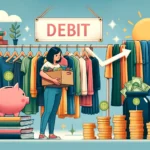In the maze of financial concerns that often cloud our minds, debt can loom as a formidable adversary, casting shadows on our hopes for a brighter future. Yet, within the web of numbers and obligations lies a beacon of opportunity – an opportunity to unravel the binds of debt and pave a path towards financial freedom.
It all begins with understanding your debt situation; peeling back the layers of owed amounts and interest rates to reveal a clear roadmap forward.
As you embark on this journey towards liberating yourself from debt’s grip, envision each outstanding balance as a piece in the puzzle of your financial well-being. By assessing all existing debts with keen precision, you not only gain clarity on your current standing but also unearth insights into where strategic measures can be employed.
Organizing these debts becomes more than just categorization; it transforms into an act of empowerment as you prioritize based on urgency and interest rates – laying down the foundation for decisive action.
Nestled within this introspective process is the seed of transformation waiting to germinate – offering you newfound control over your finances and propelling you closer to the coveted shores of debt-free living.
Join us as we delve deeper into essential steps for becoming free from debt’s shackles; let us navigate through challenges together, armed with knowledge and determination.
Creating a Budget
Tracking your income and expenses is the first crucial step towards gaining control over your finances. Start by meticulously recording all sources of income, whether it’s from your job, side hustle, or any other means.
Next, track every single expense – from fixed bills like rent and utilities to variable costs such as groceries and entertainment. By having a clear overview of where your money is coming from and where it’s going, you can identify patterns in your spending habits.
Once you have a comprehensive picture of your financial inflows and outflows, it’s time to pinpoint areas where cutbacks or savings can be made. Analyze your expenditure critically – are there unnecessary subscriptions draining your funds? Can dining out be reduced to save more effectively?
Look for opportunities to trim down expenses without compromising essential needs. Remember, even small adjustments can add up significantly over time and contribute towards paying off debts faster. By taking proactive steps to manage your budget efficiently, you’re setting yourself on the right path towards achieving financial freedom.
Building Your Safety Net: The Importance of an Emergency Fund
In the tumultuous journey towards financial freedom, having a sturdy safety net in the form of an emergency fund can be your anchor through rough waters. While the focus may rightly be on paying off debts, overlooking the criticality of setting aside funds for unexpected expenses could derail the progress made.
An emergency fund serves as a cushion against life’s curveballs, preventing you from plummeting back into debt when faced with sudden car repairs, medical bills, or job loss. It provides peace of mind and financial stability during turbulent times, allowing you to stay on course towards your goal of becoming debt-free.
When striving to build an emergency fund while simultaneously tackling debts, it’s essential to strike a balance that doesn’t jeopardize either objective. Start small by allocating a portion of your income specifically towards this reserve each month.
Treat it as non-negotiable savings – just like any other bill – to steadily grow your safety net over time. Consider cutting back on discretionary spending or seeking additional sources of income to expedite this process without compromising your debt repayment plan.
Remember, every dollar saved in your emergency fund is another step away from reliance on credit cards or loans during emergencies, forging a path towards greater financial resilience and ultimately achieving true freedom from debt.
Setting Up a Repayment Plan
When embarking on the journey to financial freedom, setting up a solid repayment plan is crucial. One effective strategy to consider is the snowball method, where you focus on paying off your smallest debts first while making minimum payments on larger debts.
This approach can provide a sense of accomplishment as you see smaller balances disappear, motivating you to tackle larger debts with renewed vigor. On the other hand, the avalanche method involves prioritizing debts with the highest interest rates first, helping you save money in the long run by reducing overall interest payments.
Negotiating lower interest rates or payment plans with creditors is another valuable tactic in your debt-free arsenal. It’s important to remember that creditors want their money back and are often willing to work with you to create a more manageable repayment arrangement.
By communicating openly about your financial situation and demonstrating your commitment to resolving debts, you may be able to secure reduced interest rates or extended payment timelines. This proactive approach not only eases immediate financial burdens but also fosters positive relationships with creditors based on mutual understanding and cooperation.
Seeking Additional Resources and Support
When embarking on the journey towards financial freedom, it’s crucial to utilize all available resources to support you along the way. Consider incorporating budgeting apps into your daily routine.
These tools not only help you track your spending but also offer insights into saving opportunities and debt repayment strategies tailored to your financial situation. By harnessing technology in this way, you can stay organized, motivated, and accountable as you work towards becoming debt-free.
One common challenge individuals face when starting their debt-free journey is feeling overwhelmed by the sheer magnitude of their debts. This can lead to a sense of hopelessness or resignation.
However, by seeking support from financial advisors or credit counselors, you can gain valuable expertise and guidance on creating a manageable repayment plan.
These professionals can provide personalized recommendations based on your specific circumstances and goals, helping you navigate obstacles with confidence and determination. Remember, reaching out for assistance is not a sign of weakness but rather a proactive step towards securing your financial future.
Conclusion
As you embark on this journey towards financial freedom, remember that every small step counts. Celebrate each milestone along the way, whether it’s paying off a credit card or creating a budget that works for you.
The path to becoming debt-free is not always easy, but with determination and perseverance, it is achievable. Keep your long-term goals in mind and stay focused on the ultimate prize of financial stability.
Recap
Throughout this guide, we have explored essential steps to help you break free from the burden of debt and take control of your finances.
From setting clear goals to cutting unnecessary expenses and increasing your income streams, each action brings you closer to achieving your dream of being debt-free.
Remember that progress takes time, so be patient with yourself as you navigate this process.
Final Thoughts
As you reflect on the valuable insights shared here, know that you have the power to transform your financial situation and create a brighter future for yourself.
Take charge of your money management skills, seek support when needed, and believe in your ability to overcome any obstacles that come your way.
Embrace this opportunity for growth and change – envision a life free from debt where financial freedom opens up new possibilities for success and prosperity.






